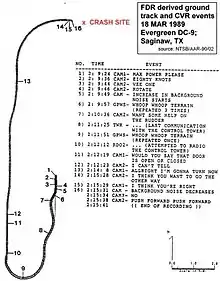Evergreen International Airlines Flight 17
Evergreen International Airlines Flight 17 was a cargo flight from Kelly Air Force Base outside San Antonio to Tinker Air Force Base outside of Oklahoma City, Oklahoma, with a stop at Carswell Air Force Base in Fort Worth, Texas operated by a McDonnel Douglas DC-9. On March 18, 1989, the aircraft's main cargo door opened after takeoff from Carswell and the aircraft crashed while attempting an emergency landing, killing both crew members on board.[3]
%252C_Evergreen_International_Airlines_JP5954210.jpg.webp) N931F, the aircraft involved in the accident in 1978 | |
| Accident | |
|---|---|
| Date | March 18, 1989 |
| Summary | Cargo door failure due to design flaw and pilot error, leading to loss of control |
| Site | Saginaw, Texas, near Carswell Air Force Base, United States 32°54′39″N 97°24′45″W |
| Aircraft | |
| Aircraft type | McDonnell Douglas DC-9-33F |
| Operator | Evergreen International Airlines |
| IATA flight No. | 4U17[1]:1 |
| ICAO flight No. | EIA17 |
| Call sign | Logair 931[1]:1 |
| Registration | N931F[2] |
| Flight origin | Kelly Field, San Antonio, Texas |
| Stopover | Carswell Air Force Base, Fort Worth, Texas |
| Destination | Tinker Air Force Base, Oklahoma County, Oklahoma |
| Occupants | 2 |
| Passengers | 0 |
| Crew | 2 |
| Fatalities | 2 |
| Survivors | 0 |
Aircraft and crew
Aircraft
.jpg.webp)
The aircraft involved was a McDonnel Douglas DC-9-33F that was built in 1968 and delivered to KLM in a dual passenger-cargo configuration. It was later converted into a full passenger-only aircraft in 1984. The aircraft was sold to United Aviation Services in March 1987 and then to Evergreen International Airlines two months later, where it was converted into a freighter. At the time of the accident, the aircraft had accumulated 41,931 flight hours, with 40,808 take off and landing cycles, and was powered by two Pratt & Whitney JT8D-9A turbofan engines.[1]:6,49[4][5][6]
Crew
The captain was 41-year-old Gerald Jack McCall, who had been with Evergreen International Airlines since 1984. He had a total of 7,238 hours of flight experience, including 1,938 hours on the DC-9. Other pilots who had flown with captain McCall described him as having a habit of checking the cargo door warning lights before takeoff.[1]:5–6,48[7][8]
The first officer was 39-year-old Thomas Bill Johnston, who had 10,863 flight hours, with 1,213 of them on the DC-9.[1]:5–6,48[7]
History of the flight
Background
Flight 17 was carrying equipment for the United States Air Force, including 12 pounds (5.4 kg) of explosives.[1]:1–4[9]
On the day of the accident, the aircraft took off from Tinker Air Force Base in Oklahoma, stopping at Dyess Air Force Base, Kelly Field Annex, then, Fort Worth Carswell Air Force Base in Texas. The flight would then return Tinker Air Force Base. After landing at Carswell Air Force Base, Air Force personnel loaded cargo onto the aircraft.[1]:1–4
Accident

According to the cockpit voice recorder (CVR), captain McCall was the pilot flying.[1]:1–4
The flight crew calculated the following takeoff speeds:
- V1 was 112 knots (207 km/h; 129 mph)
- VR (rotation speed) was 116 knots (215 km/h; 133 mph)
Flight 17 began its takeoff roll from runway 17 at 02:09:13 AM and lifted off at 02:09:46. At 02:09:49, three seconds after rotation, the main cargo door partially opened, which was indicated by the CVR recording a sudden increase in background noise. The ground proximity warning system (GPWS) activated, sounding "whoop whoop terrain" four times. First officer Johnston declared an emergency to air traffic control. The controlled asked the crew the nature of the emergency and first officer Johnston replied "okay we got a cargo door open." After ATC asked Flight 17 to report on when they were on the downward leg, the flight crew developed problems with communicated The flight climbed to 2,500 feet (760 m) and then began a right turn back towards Carlsbad. During the downwind leg, the main cargo door completely opened, causing the aircraft to yaw and roll uncontrollably. The aircraft lost altitude, inverted, and crashed near Saginaw, exploding on impact.[3] Both pilots were killed.[9]
Investigation

During the investigation by National Transportation Safety Board (NTSB), it was discovered that first officer Johnston did not fully close the cargo door, but mistakenly assumed that the door was properly closed due to its locked and latched indicators having been incorrectly applied.[3][10]:3–4
The NTSB concluded that the accident was caused by the main cargo door opening and the subsequent loss of control of the aircraft. The reason for the loss of control could not be determined. Evergreen International's inadequate procedures, the failure of McDonnell Douglas to provide emergency procedures for cargo doors opening mid-flight, and the failure of Federal Aviation Administration to issue an order for modifications to the cargo door warning alarms were also contributing factors.[3][10]:3–4
References
- "Aircraft Accident Report: Evergreen International Airlines, McDonnell Douglas DC-9-13F, N931F, Saginaw, Texas, March 18, 1989" (PDF). National Transportation Safety Board. April 23, 1990. NTSB/AAR-90/02. Retrieved December 23, 2020.
- "FAA Registry (N931F)". Federal Aviation Administration.
- Ranter, Harro. "Accident description Evergreen Airlines Flight 17". aviation-safety.net. Aviation Safety Network. Retrieved July 30, 2019.
- "N931F Evergreen International Airlines McDonnell Douglas DC-9-30". www.planespotters.net. Retrieved August 21, 2019.
- "Flyteam N931F" (in Japanese). Retrieved August 21, 2019.
- "Registration Details For N931F (Evergreen International Airlines) DC-9-33RC". www.planelogger.com. PlaneLogger. Retrieved December 24, 2020.
- "CRASH OF A DOUGLAS DC-9 IN FORT WORTH: 2 KILLED". baaa-acro.com. Retrieved September 9, 2019.
- Gamboa, Suzzane (March 18, 1989). "Two Die In Cargo Plane Crash". AP NEWS. Retrieved September 9, 2019.
- "Two killed in DC-9 crash near military base". United Press International. March 18, 1989. Retrieved July 30, 2019.
- "03/18/89 Evergreen International Airlines" (PDF). Federal Aviation Administration. Retrieved December 23, 2020.